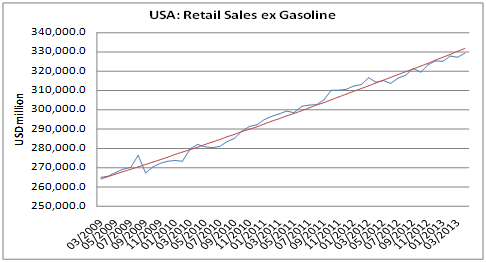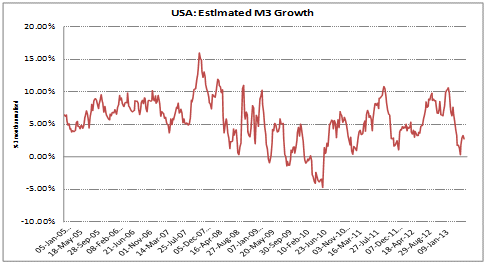Tyndall Monthly Commentary: Bernanke and QE
Quantitive easing’s next question: How do we move on from here?
Tuesday, June 4th 2013, 11:43AM
by Andrew Hunt

As we write, market participants are fretting over just what Federal Reserve Chairman Bernanke said, or indeed meant to say, in his appearance before the US Senate’s Joint Economic Committee. According to our reading of the event, there was little that was particularly new in his assessment of the economy but we do wonder if even the arch-money-printer himself, Mr Bernanke, is beginning to lose his faith in what can really be achieved through Quantitative Easing policies.
With regard to the state of the economy itself, it is clear that the US remains beset by a number of headwinds, most notably the weak world trade situation, the very soft household income trends (at least for the median household) and the effects of the fiscal tightening, but nevertheless it remains the case that the US is still managing to produce around a 4% nominal growth rate on a remarkably consistent basis. Moreover, given that inflation in general is likely to be lower this year than it was last year, this situation would seem to suggest that the economy will once again produce round about its usual 2% real growth in 2013. The economic data has clearly seen good and bad months over the last few years but in general the economy seems to have clung to a remarkably stable trend since the end of the crisis phase of the GFC.
We continue, though, to doubt that much of this realised economic growth (outside some of the spending by the very top income deciles of the population) will be overly due to the Fed’s Quantitative Easing policy effect, which now seems only to be succeeding in financing a selling of bonds by investors and companies so that they can buy (primarily) domestic risk assets. Admittedly, we have yet to gain the full first quarter flow of funds report for the US but we feel quite confident in our view that the processes that QE3 and its counterparts elsewhere have created and sponsored are having little or no impact on the real economy but that they are creating a “financing bubble” in the bond markets.

Consequently, it would seem prudent for the FRB to begin thinking about unwinding QE or “tapering it” before too long – if the process is well managed it might not have too much of an impact on the real economy (particularly if the potential unwinding of QE forces the politicians to consider more sustainable long-term solutions to the economy’s malaise) but we do fear that any unwinding could nevertheless create a massive change in financial market conditions.
Specifically – and as we are seeing in Japan at present –we suspect that any weakness in the bond markets could prove to be highly damaging to the case for risk assets and a FRB exit from QE would presumably exert a very large impact on bond prices.
There is a common misconception that the recent rally in risk assets has been due to a massive expansion in real liquidity within the global economy. Even the most cursory of glances, though, reveals that this is, in fact, not the case. Monetary growth is negligible in Europe, extremely modest in Japan and slowing in the US. Although the central banks have indeed poured money into the world’s banking systems, we find that the ongoing regulatory tightening by the world’s financial authorities, a shortage of collateral within the financial system and rising caution amongst lenders have all served to neuter the monetary impact of QE3 and its overseas counterparts.

What QE3 et al have succeeded in doing, though, is to provide “market liquidity” in the bond markets, so that many investors who were previously running very high portfolio weights to what had become very expensively priced bonds could move out of these fixed income assets and into other risk assets. Moreover, the FRB’s massive bond purchases over recent years have also created something of an issuance boom in the corporate bond markets. As a result of the Fed’s debt purchase programmes, even lowly rated companies have apparently been able to issue “junk bonds” at will and at record low yields. Unsurprisingly, this situation has resulted in US corporate bond issuance surging to a level that now easily surpasses even the previous issuance peaks that occurred during the mid-1980s, the late 1990s and 2006-7. In effect, the FRB’s actions in the debt markets have allowed a new credit boom to begin within the US corporate sector that has, in turn, been used not to finance real investment in the economy, but instead to finance a massive rise in equity buy-backs, M&A activity and share option schemes.
Consequently, although QE3 may not have created a macro-liquidity boom, it has succeeded in creating an environment in which investors could sell existing bonds, or companies could create new ones, and then use the resulting funds to buy equities and other risk assets. This has been a very powerful situation for the asset markets but it has plainly done little to help the real economies. If the FRB were to exit its QE, though, then we could safely assume that this boom in private sector sales of bonds would have to come to an end and this would then imperil the bull market in other asset classes.
Therefore, in our view at least, financial markets have much to fear from an exit from QE and we suspect that the FRB will increasingly move to encourage markets to brace themselves for such an event. Historically, the Greenspan/Bernanke-era FRB has always tried not to surprise the markets (unlike the Bundesbank, which generally believes that policy is more effective if you do...) and hence we would expect a further drip-feed of QE-moderation stories over the course of the next few quarters as the authorities attempt some form of gradual or soft exit from the markets’ QE dependence.
We should also be mindful, though, that the BoJ attempted such a “soft” exit from a QE in 2006, but the result was still an immediate and sharp selloff in JGBs that impacted asset prices in general. Although the Japanese mid-2000s QE did not end officially until March-April 2006, even we had been briefed five months earlier that it would end in early 2006 and JGB yields moved up 0.5% over those five months. With this precedent in mind, we would suggest that those investors wishing to capture the last “potential 20%” in the current bull market should keep a close eye on bond yields – if the US 10-year Treasury yield reaches 2.6%, equities will start to look expensive even at current levels.
Andrew Hunt
International Economist, London
Andrew Hunt International Economist London
| « Harbour Monthly Commentary: The Threat of Inflation or Deflation | Hamish Douglass Unplugged - Latest Video from Adviser Briefing - August 2012 » |
Special Offers
Comments from our readers
No comments yet
Sign In to add your comment
| Printable version | Email to a friend |









